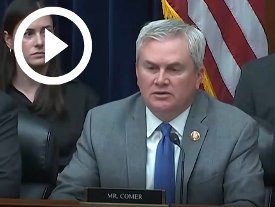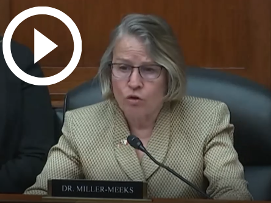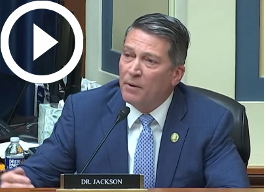School Closures Hearing Wrap Up: Preparing Our Education System to Address a Future Pandemic Starts with Holding Ourselves and Our Agencies Accountable
WASHINGTON—The Select Subcommittee on the Coronavirus Pandemic held a hearing on “The Consequences of School Closures: Intended and Unintended” to examine the impact of COVID-19 school closures on student development and investigate the role federal health officials and teachers unions played in keeping schools closed longer than necessary. Subcommittee members discussed with expert witnesses how the prolonged closing of schools was never justified by the “science” and why health officials should be held accountable for ignoring the mounds of evidence against closing schools. The witnesses also detailed the consequences of school closures on mental health, physical well-being, academic success, and behavioral regression — specifically citing studies of students throughout Europe.
Key Hearing Takeaways
The “science” promoted by our federal health officials never justified the prolonged closing of schools.
- Dr. Tracy Beth Hoeg M.D., Ph.D., a practicing physician who holds a doctorate in epidemiology, used studies of European communities to prove that COVID-19 cases did not increase when schools were open: “I think it’s important that we actually look at data from Europe that, independent of what the mitigation strategies were or what the country was, there was no relationship with the school reopening and the community case levels. And we also saw that in Brazil with community case levels and with severity of disease outcomes that, whether or not they opened or closed schools, had no impact on community transmission.”
- Mr. David Zweig, an investigative journalist and author who has extensively researched pandemic related school closures, testified that the public health guidance for prolonged school closures may have led to increased exposure for children: “And for me, when you look at the science, one of the things from talking with numerous epidemiologists like Dr. Hoeg and with infectious disease physicians and implementation scientists, is that these children did not operate in a vacuum. So even if the schools were closed, over time, they were going to interact with people anyway and in some cases in a more potentially dangerous fashion because you’re mixing with kids from five different communities in a daycare center versus had they been in school with their own individual, you know, cohort.
Examining the consequences of pandemic-era school closures on children is a step towards holding our federal health officials accountable for their mistakes.
- Mr. David Zweig described why federal health officials should be held accountable for their misguided COVID-19 school closure policies: “I would ask Dr. Walensky why the evidence that existed in front of us, real-world observational evidence, was dismissed or ignored and instead we focused on projections and models about what would happen. That is against fundamentals in the hierarchy of evidence. We chose to look at a lower form of evidence and prioritize that over real-world evidence that was occurring. I would like to understand why that happened.”
- Dr. Tracy Beth Hoeg discussed how the CDC should have consulted professionals instead of political organizations to dictate school closure guidance: “I would like to ask Dr. Walensky why, when she was creating the guidance for reopening the schools in February of 2021, that she was using the wording of the teachers unions — in terms of requiring six feet of distance — and not actually consulting the scientists and physicians who were doing the actual research, looking at amount of distancing and transmission in schools. And why it seemed like the teachers unions had a more dominant voice in creating those guidelines than the scientists.”
Children experienced historic learning loss, higher rates of psychological distress, and decreased physical well being as a result of school closures.
- Ms. Virginia Gentles, the Director of the Education Freedom Center at the Independent Women’s Forum, used the state of Virginia as a case study in her opening statement to describe the devastating learning loss experienced by students: “Virginia schools stayed closed longer than 43 other states, resulting in devastating and widespread learning loss. The state’s 13.6-point drop since 2017 in average fourth-grade National Assessment of Educational Progress (NAEP) reading scores was the largest in the nation. District and state leaders knew the harm of closures all along. Statewide testing in 2021 revealed an ‘alarming’ 20-year low in early reading skills with 34.5% of K-2 students at high risk for persistent reading difficulties, in contrast to only 21.3% in 2019.”
- Dr. Tracy Beth Hoeg highlighted the mental health crisis —specifically depression, anxiety, and suicide —facing our youth: “We do have some good data that was published in the Journal of the American Medical Association showing that there was a significant association between social closures and increasing mental health issues such as anxiety and depression. And we have data showing increased suicide rates as well in the Journal of Pediatrics that especially affected males – adolescent males and younger males as well. The increase really started in the summer and fall of 2020, those suicide rates.”
Member Highlights:
Oversight Committee Chairman James Comer revealed that public health guidance for the masking of children in schools was not based in science.
Chairman Comer: “Dr. Hoeg, that document that I referred to recommended schools require the universal masking of children and six feet of physical distancing. Were those necessary to keep schools open?”
Dr. Hoeg: “…We had evidence prior to the pandemic that masks were largely ineffective at preventing community transmission of influenza and other upper respiratory viruses and we did not obtain any new, high-quality evidence during the COVID-19 pandemic that masks are an effective mitigation strategy in schools or outside of schools.”
Chairman Comer: “The mask guidance was not scientifically sound?”
Dr. Hoeg: “Correct. It wasn’t scienced based and the six feet of distancing was arbitrary. That was based on basically just looking at how far certain sized droplets spread. It wasn’t based on actual transmission of disease.”
Rep. Nicole Malliotakis (R-N.Y.) laid out a pattern of abuse, misuse, and fraud related to COVID-19 aid allocated to schools across the country.
Rep. Malliotakis: “The inflationary American Rescue Plan, which the Democrats passed in March of 2021 with their one-party rule, it was billed as a necessity for reopening schools after the COVID-19 pandemic. They decided to spend this money despite a trillion dollars sitting there, unused from the previous packages. This ARA provided another $122 billion for elementary and secondary schools. It was so critical. They need this money. They could not open the schools without it. Guess what? As of November, only 15% of that money has been spent.”
Dr. Mary Miller-Meeks (R-Iowa) described her early attempt to keep schools open by presenting scientific data to government officials.
Dr. Miller-Meeks: “I recommended to our governor and to our legislators that we not close schools, especially elementary, because the data we had at that time, the scientific data we had at that time, indicated that children were of minimal risk and did not seem to be good transmitters of the virus. Later, I submitted to our Senate the American Journal of Pediatrics article in June or July of 2020 that indicated that there was very low transmission, and at that time recommended that schools should not be closed. But the CDC did not follow that guidance.
“Dr. Hoeg, are children less susceptible to COVID-19 infections than adults?”
Dr. Hoeg: “Early on in the pandemic, we saw that they were less likely to be infected, but they’ve always been much less likely to experience severe outcomes. And as I discuss, that’s greater than a thousand-fold difference between children and older adults, and that continues to be the same in terms of severe outcomes that children are much, much less impacted.”
Dr. John Joyce (R-Pa.) highlighted the mental health crisis created by prolonged school closures and limited physical activity.
Dr. Joyce: “So as a physician, as a doctor, do you feel that the school closures accentuated long-term mental health issues in children?”
Dr. Hoeg: “I’m concerned that they did because the correlation…”
Dr. Joyce: “And school related activities, whether it was being on the soccer field…”
Dr. Hoeg: “I mean, we’ve seen also evidence that decreased participation in sports activities have been associated with increased depression rates, specifically during the pandemic. And we know that many children get access to sports and physical activity through school. I think it’s difficult to say, that it would be extremely difficult to say, that the school closures had no impact on this mental health crisis that we’re seeing right now in our youth.”
Dr. Ronny Jackson (R-Texas) pressed Executive Director of the National Association of School Nurses, Donna Mazyck, for answers regarding her role in the CDC’s guidance for school closures.
Dr. Joyce: “I think it’s very concerning that you can’t remember, as the Executive Director, whether you had any type of conversation or any type of communication about that at all. I mean, I think you could easily say ‘I did.’ I don’t know the details. I can’t relay to you the extent to which these conversations took place. I’ll get that to you in writing, but you’re saying you do not remember having any of those conversations?”
Ms. Mazyck: “No, I don’t. What I do know is that the National Association of School Nurses depended on the guidance that was issued from the CDC.”
Dr. Jackson: “I understand that. What I want to know is did they participate in developing that guidance along with the teachers union? I think this is a very important question. I think that this is just the beginning. We’re just starting to scratch the surface of what happened here.”




